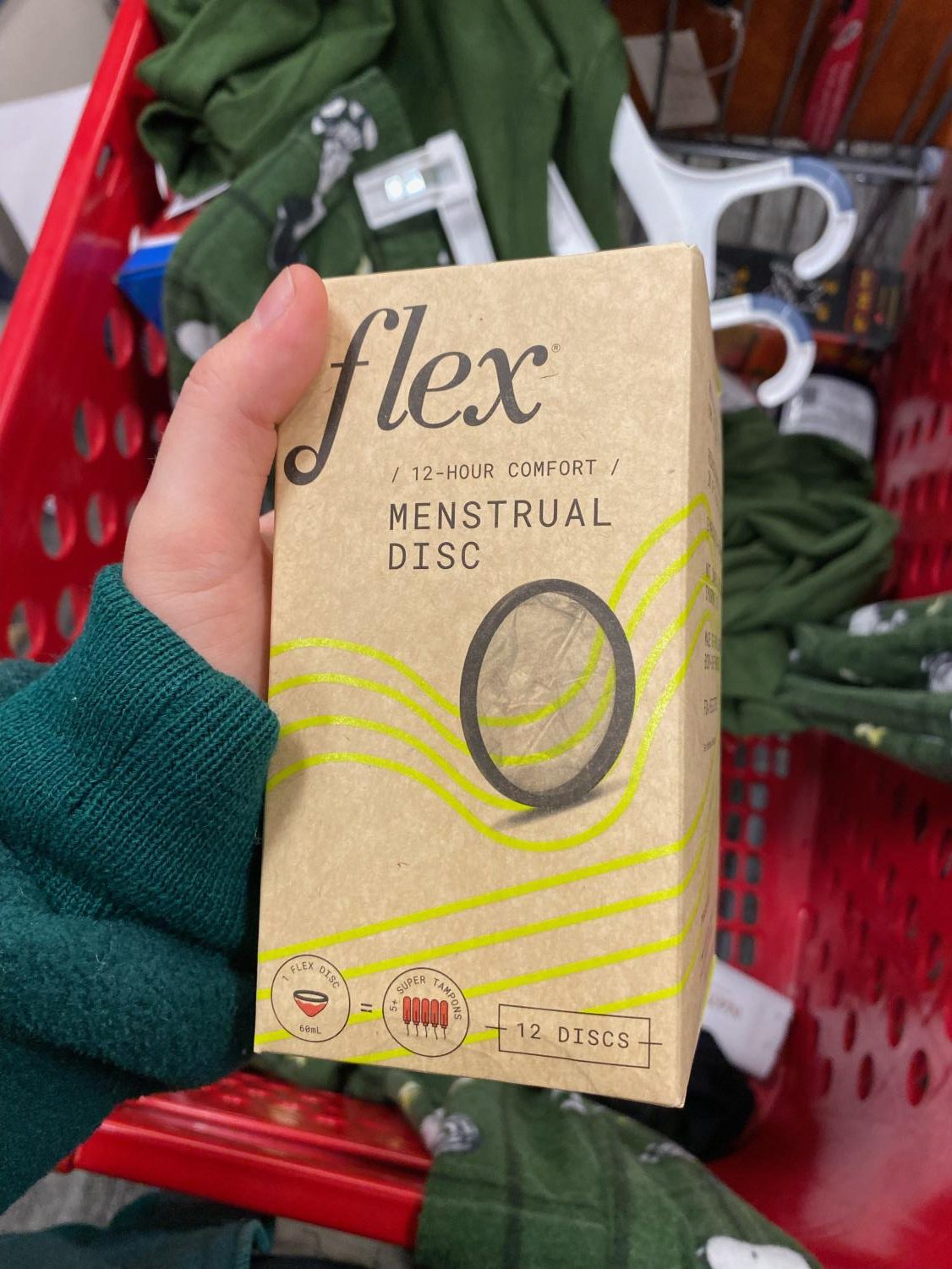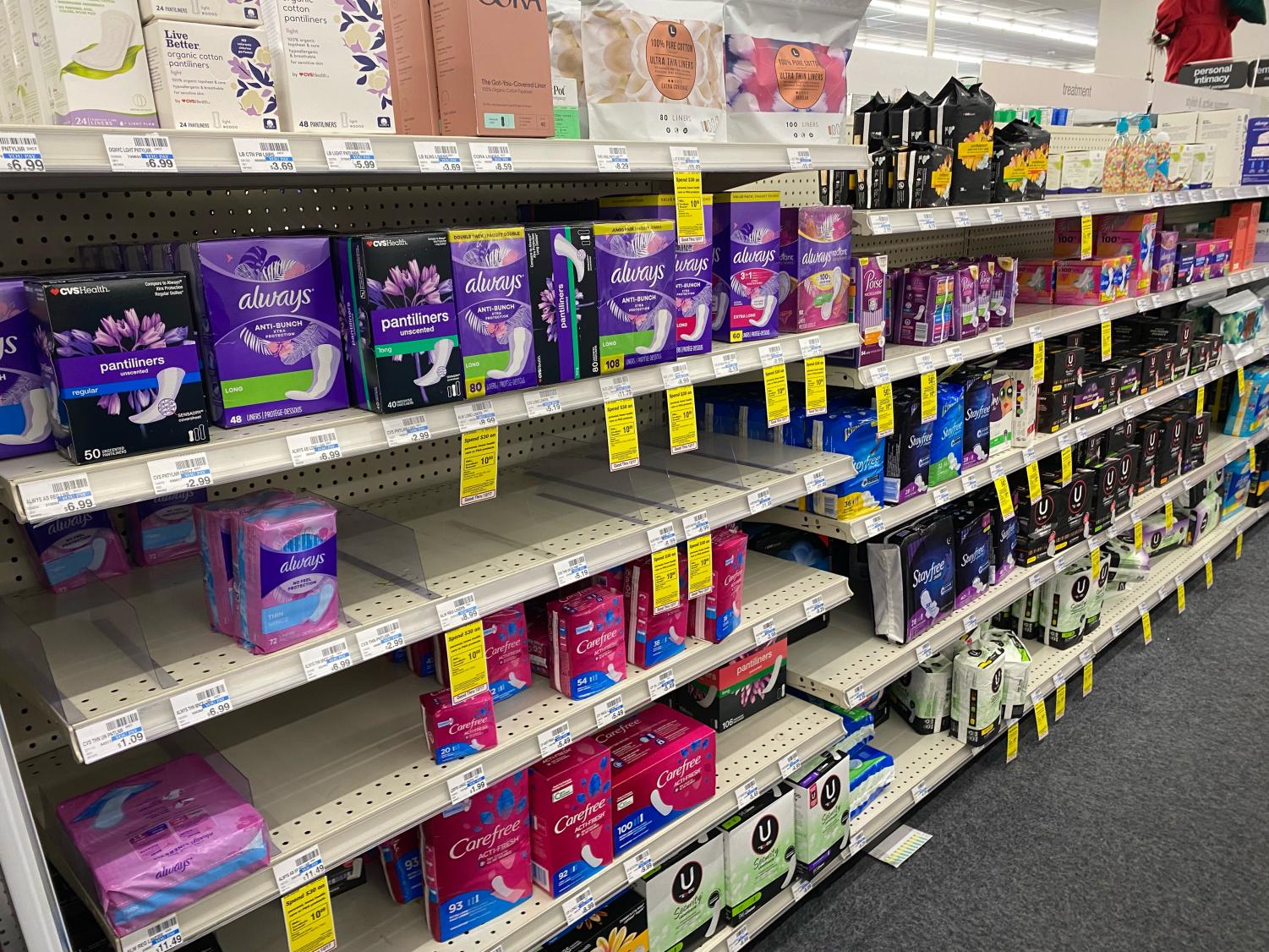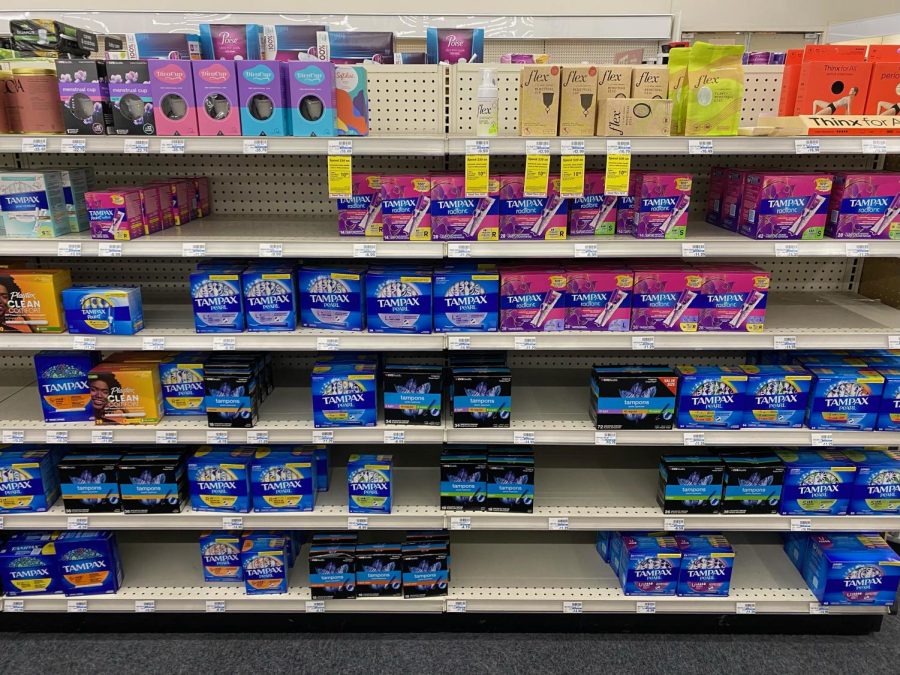Sustainability, period
Feminine Product aisle at CVS
December 15, 2022
For a person who menstruates, their period is often a monthly inconvenience; from the physical discomfort and exponential cost of pads and tampons, to the growing awareness of single-use plastics, knowing what products to use can be a challenge. Thankfully, a surge of reusable options have become available and increasingly popular.
Before our modern world of disposable products, most everyday items and their packaging were reusable, even for periods. What we know today as pads and tampons used to be made from woven fabric or flannel that was reused for every cycle. However, they were not the safest, especially for continual use. According to “The Girls Company,” cloth pads used in the 1800s proved to have major health risks from bacterial growth from both menstrual blood and fecal matter since they were not cleaned well.
Period products transitioned from reusable to single-use materials throughout the 1900s. Soon enough, Tampax was introduced and became the first disposable tampon for menstruation. Later in the 1980s, pads with wings and different size options hit drugstore shelves.
Of course, the introduction of these new products came with the introduction of new risks. Between 1979 and 1996, 5000 instances of Toxic Shock Syndrome (TSS) were documented. The cause of these cases was the over-absorbency of new tampon brands, which are luckily no longer available for purchase or use. The overwhelming number of TSS cases caused widespread concern and placed an emphasis on finding organic and natural alternatives for the safety of people with periods.
In the present day, the resurfacing of reusable menstrual products connects the concern of the user’s health and that of our planet. Especially as the climate crisis gains more awareness, the question of ‘what is the best and most eco-friendly period option for me’ has reached the minds of many menstruators.
How tampons affect your health
In recent years, the term ‘sustainable’ found a connection with the topic of periods to encapsulate the want of both helping the Earth and an individual’s health.
“[The term] ‘sustainable menstrual products’ [means that] whatever resources are used to gather and make them are gathered in a sustainable way to both the land and to the people that are creating them,” human biology teacher Camille Erskine said. “The second part that stands out to me is the way that it works within the human body, […] making sure that it’s not adding in any additional toxins or stressors or pH changes.”
As the composition of disposable pads and tampons have developed, many period companies began using harsh additives that harm the health of users.
“Pads and tampons in particular […] use bleach in order to change the color as well as dyes. And there are even some scented menstrual products,” Erskine said. “So the more foreign things you come into contact with, the more likely you are to have some sort of reaction to it or discomfort and so it’s just really important that we are […] fully aware of what’s going into our bodies.”
The use of scents not only harms the physical well-being of the user but also affects their acceptance and comfortability about their period. By telling young people to mask their natural period odor with toxic chemicals, we contribute to the stigma of natural bodily functions. With natural and sustainable period products, user health can improve and shame is reduced.
“[Using sustainable products] gives people a choice and autonomy over what’s happening with their bodies. And that is something that everybody needs more of,” Erskine said. “It allows you to make certain choices, especially if you are aware of your body and if you know that you get thrown out of whack really easily. You should also be aware of things that could irritate [you] so that you can take mitigating factors to not have the discomfort of things that do pop up continually like BV or yeast infections.”
Sustainable menstrual products also help empower people with periods during an uncomfortable time. Through the growing awareness of reusable period products, the concept of menstruation is destigmatized.
“There’s a lot of shame and stigma around periods,” senior Sustainability Club treasurer Madison Duran said. “So I think having this kind of sub-genre of understanding of periods, understanding of how we get through them and the products that we use, I feel like it can be uniting because you recognize this thing that no one talks about [impacts] the plastic problem. You’d like to see that impact, and then you’re taking the steps to make a difference […], I think that can be kind of empowering.”
Types of sustainable products
Whether a product is reusable or disposable, the main two options for period management consist of internal and external products. When searching for a sustainable alternative, identifying these two categories can help a person decide what might be most comfortable and useful for their body and lifestyle.
“External products [are] worn on your body [while] internal products are worn in your body. So external products are going to be alternatives to pads, like reusable pads, reusable liners and period underwear,” Sequoia alumni Skylar Wiggin said. “[As for] internal products, we have menstrual cups and menstrual discs. These are made out of medical grade silicone, inserted into the vaginal canal have a very low risk of toxic shock syndrome, and they hold way more blood than tampons.”
For sustainable external products, a popular option is period underwear. A cross between clothing and a reusable pad, period underwear has gotten some criticizing remarks regarding possible leakage and its comfortability. However, this variation of disposable pads has continued to be a favorite for many menstruators since its start.
“It’s not too compression-y to where you feel like if you’re bloated you’re like compacted and it’s uncomfortable,” Duran said. “The lack of leaking that I’ve had with period underwear– it’s lovely, I have no complaints.”
One of the more popular and well-known options is a silicone menstrual cup. This tool sits in the vaginal canal similarly to a tampon and collects period blood for up to 12 hours.
“If you are comfortable with blood and bodily fluids, I think it’s a fantastic option. Because as somebody who would have to be really aware of how long a tampon was in my body and needing to be able to know that it will have access to a bathroom to change it, that same issue doesn’t exist with the cup for me,” Erskine said. “Personally, I was able to keep it in all day and all night so only having to change it once in the morning and then once at night, and it kind of decreased my anxiety around being like in social settings and unaware of bathroom availability.

A second option for an internal product would be a menstrual disc. Menstrual discs are typically larger and can be found as a disposable, reusable, or purely plant-based product. While the size can be daunting, the comfortability of the disc is outstanding.
‘It doesn’t use suction which I was kind of worried about. It sits higher up in your vaginal canal, so you truly can’t feel it,” Wiggin said. “There’s no fancy folds or anything, it goes in place, and it’s chilling.”
One common place of hesitation for many people is the fear of touching their own menstrual fluid and the maintenance that a sustainable product requires. However, Wiggin argues that reusable period products come with a level of sanitation that far outweighs that of a disposable one.
“With my menstrual disc, there’s no odor or anything. When I’m on my period [and I use] pads, [there is a] weird smell immediately,” Wiggin said. “[The other part is that] you’re cleaning it and it just feels very sanitary and controlled and there’s no bacteria growing everywhere. So I would like to encourage people to get over the initial fear of, ‘oh my goodness, I will be interacting with my own blood.’”
Another important factor of deciding what product is best for you is understanding the materials it is made out of. There has been a misunderstanding of what is sustainable because of the increasing popularity of biodegradable products.
“Biodegradable things are still made out of plastic. They’re not organic material, but if they end up in the environment, they’re gonna break down. So instead of having these big bottles floating in the oceans, you have a bunch of microplastics. The plastic doesn’t go away, it just gets smaller,” Duran said.
A new option for sustainable period products are compostable, plant-based alternatives. After someone is done using the product, it will decompose naturally because its materials are completely organic.
“Plant-based plastics are interesting, because usually, they interact with something in the environment and that’s what makes them start to break down, or they have a certain life before they’ll break down,” Duran said. “If you actually follow the directions, you’ll be okay. [It’s not something to be scared of], plant-based plastics, where you’re gonna die because it’s decomposing inside of you. That’s not gonna happen.”
Why you should use a sustainable menstrual product
While developments to modern disposable pads and tampons appeared to be a smart idea when it was invented, the long-term effects of continually using these products are detrimental to our planet.
“Pads and tampons are so wasteful. A lot of times you’re not even using them to capacity because you’re changing them when it’s convenient. There’s so much plastic, especially in pads, it takes forever to break down,” Wiggin said.
Even though menstruation is a monthly occurrence for nearly half of the world’s population, we rarely think about the effect these products have on our planet. This wastefulness causes the trash produced by disposable pads and tampons to increase.
“There are roughly 400 pounds of period products, […] the packaging included, that’s thrown out per one menstruator’s lifetime,” Duran said. “If we’re thinking on a global level, annually, not including packaging [and] shipping for just pads and tampons, 12 billion pads and seven million tampons will end up in landfills. And this is excluding anything that ends up in waterways or random ones thrown out from stores that don’t get bought […], this is just what’s in landfills, which is insane.”
Aside from the accumulation of period products in landfills, pads and tampons can find their way into environments, thus affecting the wildlife and people living in those areas.
“A lot of tampons end up in waterways because people will sometimes flush them down the toilet,” Wiggin said. “Especially in countries that have less developed sanitation systems, if all of the waste is just being dumped into a landfill out in the open, then everything is free to go wherever which is not great.”
Accounting for all the ways that menstrual products have been treated, single-use items can cause more harm than good. The introduction of foreign chemicals into a person’s body can cause serious issues.
“For the person that is using the products, it’s first really important for their own health because that is such a vulnerable location of the body. Anywhere that can be exposed to outdoor external environments and therefore have access to pathogens, you want to make sure that that area is able to maintain its healthy balance,” Erskine said.

Accessibility issues
From environmental reasons to personal health protection, using a sustainable period product is ultimately the best decision for both your body and the planet. However, its price often makes the products inaccessible.
“I think the hardest thing is that there’s obviously a cost barrier that exists there. The menstrual cup was like $20, maybe it was more,” Erskine said. “I remember […] when I was purchasing it, I was like, ‘I hope I use this,’ because I just [spent a lot of money] on it.”
While the initial cost of a sustainable product is inaccessible to some, the long-term savings on disposable pads and tampons should be noted.
“If you buy a cup or disk it’s a $30-$40 investment up front. But, you may not have to buy any other product for the next 10 years, which is insane when you think about the cost per year. You can’t spend $3 on your period a year if you’re buying pads and tampons every month,” Wiggin said.
Education, advertisement and the stigma around periods increase the inaccessibility of sustainable products. In order for a more sustainable world with healthy bodies and a lack of tampon trash to emerge, changes in our government systems need to be enacted for these options to be more widespread.
“We need policy and structural change. I think it would be great if in the same way you can get access to condoms and other sexual health services for free, [you can get a sustainable period product], at least to get started. In some ways, it would be fantastic if there was a similar process for this, where maybe even like menstrual product drives […] where people are able to donate these things or allow more people to have access [to them],” Erskine said.
Advice on starting to use a sustainable product
Starting a new period product can be daunting, especially with a drastic change in materials, the responsibility of cleaning the product and the task of using it altogether.
“I feel like in America, there’s a big culture of like, you know, we have like the fancy plastic applicator tampons, so that you really do not have to touch your vagina ever on your period if you don’t want to. And that can be comfortable, but like there’s nothing shameful about like using your fingers to insert a menstrual product,” Wiggin said.
If you are around family members who you are not comfortable talking about periods or menstrual health, purchasing the product itself can be scary.
“If you go with a parent, bring cash, grab it yourself, and go to self-checkout. And then, just meet them on the other side of the register. You can shop with them the whole time and then you can slip off at the end when you’re walking towards the cash register and grab it,” Duran said.
Education is key, especially in finding a new menstrual disc or cup to try. Thankfully, online support groups full of information are readily available to help any interested person who is looking to find what period product might be best for them.
“Look at all the resources that are around you. I think social media is a great tool, […] I personally joined [a] group and people will talk about [issues and questions they have],” Erskine said.
Sustainable products are overall better for you and the environment. If you are debating on trying something new and reusable, there is a community out there to encourage you to make this transition feel less scary.
“I feel like it can be very empowering to be comfortable with your anatomy enough to know how to use a cup or disc. And so it can feel scary, [but] you’ll learn the ins and outs of how to use the product and just feel more connected with your body and hopefully, periods won’t feel so dirty or shameful,” Wiggin said.







